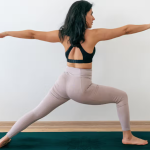We’ve all seen the photos of the re-opened gyms in Hong Kong with perspex screens between each running machine. There have also been yoga classes with each student confined inside a plastic sheeting cocoon. It looks futuristic, other-worldly – and bleak.
On Tuesday, the government announced measures to further ease the lockdown from Saturday 4th of July – aptly Independence day in the States. There will still be social distancing measures in place, but these will now be reduced to ‘one-metre plus’ where two metres is not possible, and with the addition of face coverings, additional hygiene, and altered layout for indoor public spaces. However, gyms, swimming pools, and by default – yoga studios – are not included in the businesses allowed to open from the 4th.
As disappointing as this will be for many, there is a (yet unconfirmed) rumour that mid-July is now set as the date. At some point, in-person classes will return. So let’s take a look at how yoga classes can operate NOW under the current guidelines – and IN THE FUTURE when the restrictions are lifted.
Ways You Can Teach Yoga NOW
Teaching Outside
With the ongoing uncertainty around indoor yoga teaching, outdoor classes could be an option.
Currently, the limit to any group gathering outdoors is up to six people from different households. This is with the proviso that you observe the two metre rule unless that person is from your own household or within your support bubble.
However, there are rules and regulations for teaching in a public park too (of course). If your class is free you won’t need to worry about that. But if you’re charging then you’ll need to get a license to teach. There are no standardised regulations for outdoor exercise licenses, so you’ll need to check your local council’s website for more information on their licensing rules.
It will of course be weather-dependent, and with the great British weather being what it is, it will be worth building in some backup plans in case you need to cancel. Make sure every attendee gives you a contact number so you can cancel at short notice. You’ll also need to have an online booking and payment system (this one, for example) to ensure that you don’t exceed the current regulation of six people and to avoid any cash transactions.
Teaching Online
Many yoga teachers made the move online within the first few weeks of the lockdown. Since then there’s been a steep learning curve as the technophobes among us have got to grips with new technology – as well as some not-so-new technology! Both teachers and students have begun to adapt to the ‘new normal’, and some interesting advantages have emerged.
- Classes can be flexible – with no venue to worry about, time slots can be changed as needed.
- Students are learning to be more responsible for their own bodies as they get to grips with practicing at home.
- Many more students have made space in their homes for yoga practice.
- Many students have invested in yoga equipment, meaning that they can practice at home.
- Teachers have enjoyed saving both time and energy spent on rushing to venues.
- Apart from subscribing to online platforms, there are very few costs involved.
- Your students don’t have to be local!
So, for now, there is plenty to enjoy about teaching online. However, there is also a lot that yoga teachers miss about the in-person experience. Some students haven’t made the leap to online classes and for them, knowing when we can teach in-person again is paramount.
How We Can Teach Yoga in the FUTURE
Practical Measures
Sticking to Legal Requirements – Guidelines are changing week by week, and the first thing to do before planning any move back to is to keep up to date with government and local council guidelines. You can sign up to get email alerts when the government puts any update on Coronavirus onto the Gov.uk website. Remember that in order to comply with your PLI (Public Liability Insurance), you will need to stick to the government’s social distancing policy and all other guidelines.
Pre and Post-Class Cleaning – If you own your own yoga studio, even if it’s a small cabin in the back garden, you will be responsible for adequate cleaning of the space before and after each class. Stock up on plenty of cleaning supplies and think about having a cleaning plan, such as focusing on high contact areas such as door handles. You should also keep a record of this cleaning, especially if you’re a studio owner. Students should bring their own yoga equipment wherever possible. Shared facilities such as toilets should also be cleaned as regularly as possible.
Class Hygiene – Both you and your students will need to practice increased hygiene measures, including washing hands before and after classes. You could also consider providing antibacterial wipes for students to clean their own areas. Hand sanitiser should be freely available throughout the studio/your class space. The movement of students during the class should also be reduced to avoid cross-contamination.
Social Distancing – Class sizes will need to be reduced to adhere to social distancing guidelines, which will involve pre-booked classes only. Once inside the class, you might want to think about marking out mat spaces using tape on the floor where this is possible. Physical adjustment of students is also not allowed due to the social distancing measures. You could consider getting the students to do their own physical corrections through demonstration.
Make sure you leave enough time between classes to reduce congestion in waiting areas. You might also want to have signs to indicate a socially-distanced queue system to enter classes, or if space allows, a one-way system of movement through the building – such as most shops have now introduced. Consider asking your students to arrive already changed to avoid excess time spent in the building.
Ventilation – While the weather is still warm it would be preferable to have windows open, as the use of air conditioning can re-circulate air, which could lead to the spread of infection. On this note, singing in enclosed public spaces is also prohibited as it poses a particular threat of spreading the virus. If you usually chant in your classes, then you could encourage students to sing silently in their heads, or you could play a pre-recorded version.
Face coverings also help to reduce the spread of airborne virus particles, and where possible, these should be provided. If you’re going to use these, they need to be put on before class, and not taken off till the class is finished.
Symptom Checker – The government slogan is currently ‘Stay alert’, which means that as a yoga teacher or studio owner you’d need to stay alert to the threat of infected students attending your classes. Make sure you remind students not to attend if they have any symptoms, or if anyone in their household (or extended bubble) has symptoms either. If possible, check students’ temperatures at the door using a remote thermometer.
Keep a record of everyone who attends classes so that you can comply with the track & trace system. Make sure you have up-to-date contact details for all students in case you need to cancel classes at late notice due to any risk of infection.
Think about Online AND In-Person Classes
When in-person classes can start up again there will be no guarantees that students will be ready to return to in-person classes. For many teachers and studios, an online and in-person hybrid will be the best business model until the new measures are normalised.
This means that you should be able to maximise the number of students able to attend. Consider offering bespoke smaller classes in-person, to be offered on top of your current online timetable. This means that those students who’ve been unable to do online yoga will be able to return to classes.
A Disclaimer
These are suggestions for how you might manage face-to-face yoga classes, but as mentioned quite a few times, guidelines are changing all the time. It might be that the social distancing measures are relaxed, on the other hand, we could end up heading back into full lockdown.
This situation has taught us that everything that we thought of as being normal life can change – and fast. So while we can do our best to plan for the future, it might also be wise to take it things week by week.













